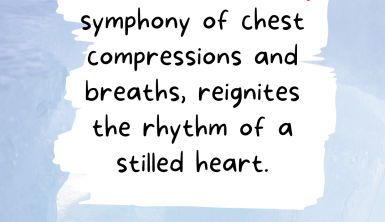Rescue Breathing
Medical emergencies are typified by unexpected scenarios involving injury or illness. Emergencies have a looming sense of urgency where every consequent action significantly counts. In the event that someone ceases to breathe and falls unconscious, rescue breathing is pivotal in the revival and successful recovery of this individual.
Rescue breathing, colloquially denoted as the kiss of life, goes by many other names such as artificial respiration and cardiopulmonary resuscitation. Rescue breathing is a ubiquitous skill for first aiders and medical professionals and fundamentally encompasses breathing for somebody else.
How It Works
The physiology behind rescue breathing is quite rudimentary and involves three organ systems which collectively work together to maintain life. They are the respiratory, cardiovascular, and nervous system.
The lungs enrich the blood with oxygen which the heart delivers to the rest of the body with the instruction of the brain. When either of these organ systems fails, the process of death ensues. If an airway is obstructed, oxygen delivery to the brain is interrupted leading to cell death within minutes.
The miracle of rescue breathing or CPR is that by simply administering breaths to a casualty’s lung and compressing the chest at regular intervals, it can help save a life.
When to administer rescue breathes
Not all medical emergencies warrant the administration of rescue breathes for mitigation of injury or illness. A casualty may need rescue breathes in the following scenarios:
- Choking
- Near drowning
- Carbon monoxide poisoning
- Severe asthma attack
- Drug or alcohol overdose
- Performing CPR
Before commencing the administration of rescue breaths there are a couple of guidelines one should concern themselves with. First and foremost, do not perform CPR if you are not trained to do so. This only places the casualty in danger and may elicit legal retribution. Call an emergency number and patiently wait for first responders to arrive.
Before performing CPR on a casualty it is prudent to first clear the scene. Scan your immediate surroundings for obvious hazards and try to remove them. For instance, if your casualty has been involved in a car crash, transport the victim safely away from the wreckage if possible. It is ideal to use protective gear such as gloves or a respiration mask to administer CPR.
The following are the steps taken when performing CPR on adults or older children who have reached puberty. To confirm a casualty has reached puberty look for body hair and or breast development.
Step 1: Place casualty on their back
It is critical to place the victim on their backs as this position accommodates the procedure you are about to administer. This position is safe for both you and the casualty and provides enough room for the procedure to be performed successfully.
Additionally, lying on your back makes it easier to open up a victim’s airways.
Step 2: Check for consciousness
Gently shake or tap the casualty to see whether you will register any response from them. Ask simple questions such as “Are you okay?” and monitor to see whether they give any verbal or physical response.
Do not shake a casualty whom you suspect to have a back or neck injury. This will only aggravate the extent of the physical damage. Do not proceed in action when in doubt.
If the casualty does not respond proceed as elucidated in steps 3-6.
Step 3: Open the airway
To open the airway, first place the victim on their back, with their head facing upward. Against the casualty’s forehead, slowly and gently press your palm. Simultaneously clip two fingers or as necessary below the chin of the casualty and slowly elevate the chin away from the spine. This movement is synonymous with pulling out a drawer.
This movement tilts the head backward and opens up the airway.
Caution should be taken if there is a possibility of a neck injury such as a broken neck. If so, or if in doubt, place the victim on his or her back without moving the chin and neck.
Step 4: Check for breathing
Once the victim is in the desired position it is easy to monitor their breathing or lack thereof. Check to see whether the chest is rising and falling and the frequency at which it does so.
Additionally, listen keenly to normal breathing. Ensure the victim is not gasping for air or heaving sporadically.
If you register abnormal breathing patterns, administer rescue breaths as elucidated in step 5-6.
Step 5: Pinch and Seal
Keep the victim’s chin down and head tilted back. Proceed to gently peg the casualty’s nostrils together gently using your index finger and thumb. Position your mouth over the victim’s mouth to form a seal with your lips.
Step 6: Rescue Breathes
Breathe into the casualty’s mouth gently and monitor whether his or her chest elevates. Pause for a period of five minutes and repeat the breath while checking the patient’s pulse. Continue breathing into the patient’s mouth, every five seconds until she or he is able to, or until the emergency first responders arrive at the scene.
If the patient records no pulse, you are required to administer CPR as explained in step 7.
If it is evident that air is not moving into the patient’s lung, it may be due to an obstruction of the airway. Using a gloved hand, gently open the patient’s aw and check the throat for signs of blockage.
Remove the obstruction using the swipe of your forefinger or the use of sterile tweezers to safely eliminate the object causing a blockage.
Step 7: Compressions
To perform chest compressions, kneel next to the victim and locate the finish of the breastbone. Squarely place two fingers on the apex of the breastbone, usually where the ribs converge.
Place the back part of your other hand above your fingers on the side nearest the victim’s face. Stack your other hand over the one in position and fasten the finger of your hands together. Do not touch the chest of the casualty. To do so, raise your fingers.
To start doing the compressions, lock your elbows by extending your arms and positioning your shoulders above your hands.
Using your body weight thrust downward, pressing directly against the breastbone, so as to distend it at least 5cm down. Let the chest dilate after each compression.
Continue giving a cycle of 30 compressions and two rescue breaths until first responders arrive at the scene or the patient begins to breathe normally again.
Conclusion
It is prudent to be prepared for medical emergencies. You can get trained and certified by taking a CPR class with us and help to save the lives of those in need.







